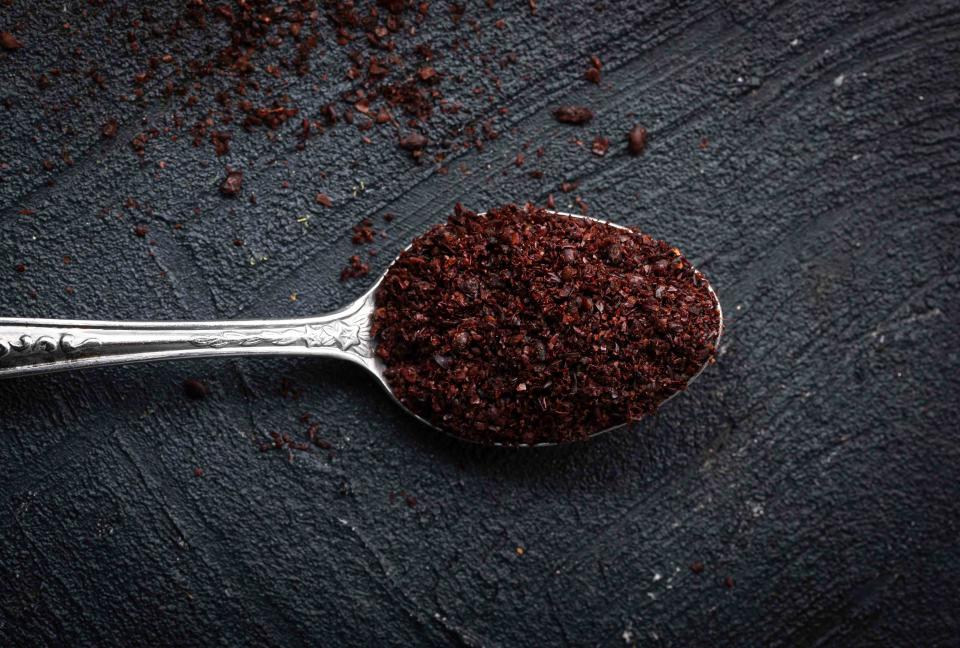What Is Sumac? A Guide to the Bright and Lemony Middle Eastern Spice
This vibrant crimson powder adds a tart, earthy flavor to sweet and savory dishes. Here’s everything you need to know when choosing and using it.

oykuozgu / Getty Images
With its vibrant maroon hue, sumac may catch your eye before anything else, but its earthy, slightly lemony aroma and tart flavor will inspire you in the kitchen time and time again. The popular Middle Eastern spice is delicious when used as a dry rub for roast chicken, sprinkled over roasted nuts, whisked into salad dressing, or stirred into pickled onions. Get to know this vibrant spice — how to shop for it, what it tastes like, and how to cook with it.
What is sumac?
The word sumac is derived from the Arabic word summaq, meaning “dark red.” “Culinary grade sumac is produced from the fruits of the sumac tree (Rhus coriaria), also known as Sicilian or tanner’s sumac,” explains Alex Wilkens, vice president of product at The Spice House. “These bright red drupes are harvested, dried and cured with a bit of salt, and ground into a beautiful crimson powder.”
Sumac grows well in temperate climates including the Mediterranean, East Asia, North Africa, and North America. The dry powder is used as a spice in sweet and savory dishes, and is a key ingredient in za’atar, a warm and versatile Middle Eastern spice blend.
Related: A Guide to Za’atar, the Flavorful Middle Eastern Spice Blend
How to shop for sumac
You can find dried, ground sumac in the spice section of your grocery store or from speciality retailers. “High-quality sumac should appear rich and shiny, almost oily, with a deep crimson color,” says Wilkens. “If sumac powder appears dry, dusty, or dull, keep shopping.”
When buying any spices, purchase them from a brand that responsibly sources its spices and values freshness, such as Burlap & Barrel, The Spice House, or La Boîte. Sumac will last for up to two years if stored in a cool, dry place. If you have some in your pantry and are wondering if it’s still good, give it a sniff; if it still has a pleasant aroma, that’s a sign that it still has flavor. If it smells like nothing, toss it and buy fresh sumac.
How to cook with sumac
Dried sumac adds a tart, earthy, and lemony flavor to both sweet and savory dishes. “A bright sprinkling of sumac is a classic way to dress up a plate of hummus, grilled kebabs, or quick pickles,” says Wilkens. Sumac is also a traditional ingredient in fattoush, a refreshing Middle Eastern salad made with toasted or fried bread, and it’s delicious in a dry rub or marinade for roasted and grilled vegetables or meats, like a Spiced Leg of Lamb.
Beyond its classic uses, sumac is incredibly versatile. Try it in a scallion-sumac gremolata or sumac and Italian dressing. An entire tablespoon of sumac is added to the custard for this Lemony Sumac Pie with Ritz Cracker Crust, and it lends its bright flavor to the berry topping for this Double-Decker Meringue Cake. It can also be used in a salt for rimming Margaritas or other cocktails.
Related: How to Buy Spices Like a Pro
Sumac substitutes
While you won’t be able to recreate sumac’s saturated red color, you can mimic its bright, tangy flavor with other ingredients. Substitute dried sumac in a marinade or sauce with other acidic ingredients like lemon zest, tamarind paste, pomegranate molasses, or apple cider vinegar. It’s not a seamless swap, so be sure to taste and adjust the seasonings as needed. You can also use a combination of chopped fresh parsley and lemon zest as a garnish in place of sumac.
For more Food & Wine news, make sure to sign up for our newsletter!
Read the original article on Food & Wine.


